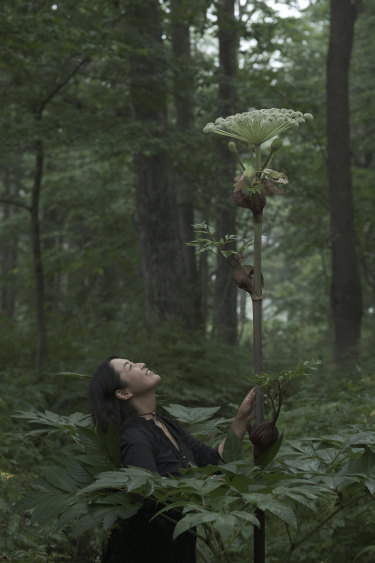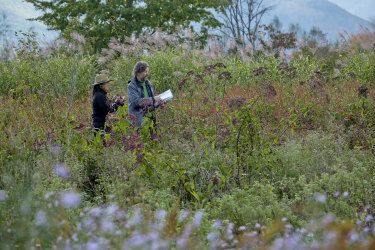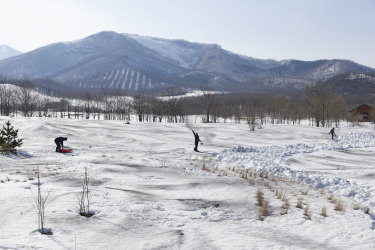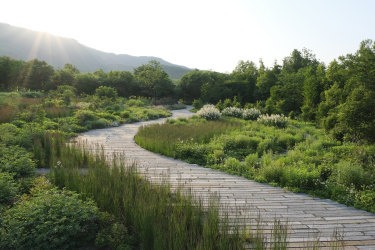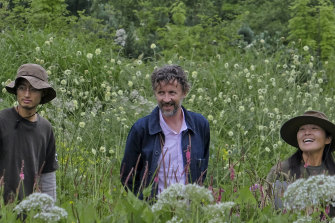It’s covered in snow for more than six months a year, is lashed by driving horizontal sleet in autumn, has a fleeting spring and a condensed summer, but the northernmost island of Japan is exactly where Japanese entrepreneur Mitsushige Hayashi wanted a garden that would last 1000 years.
Hayashi was enchanted with Hokkaido’s rich alluvial valleys, by its wild ridges, forests and weather. One spot at the base of the Hidaka Mountains especially resonated and there, about 30 years ago, he began to plan for the creation of a vast public park that would beguile others as much as it beguiled him and offset the carbon footprint of his national newspaper business.
Midori Shintani with Angelica ursina.Credit:Kiichi Noro
The resulting Tokachi Millennium Forest has been hailed as one of the most exciting gardens in the world. Much of its success stems from the close partnership forged between the place’s British landscape designer Dan Pearson and its Japanese head gardener Midori Shintani.
The two met on site in 2008. Pearson had already been working there for eight years but Shintani had only just arrived. “We were quickly at ease,” Pearson writes in the recently published book Tokachi Millennium Forest. “I explained that all the answers lay here in the (wild) forest and that the way things grew together was our guide.” She saw things the same way.
Shintani will speak about her approach to gardening in an online talk at this month’s Australian Landscape Conference. In an interview via Zoom from her home a 45-minute drive from the forest, Shintani talks about the importance of darkness, shadows and the sense of quiet in the Hokkaido gardens and how one of the things she and Pearson first bonded over was a 1933 meditation on Japanese aesthetics, called In Praise of Shadows by Junichiro Tanizaki. “That’s the book that got Dan and I closer as friends, we felt like we could see in the same way,” she says.
Midori Shintani and Dan Pearson observing the garden in autumn.Credit:Kiichi Noro
Pearson lives in Somerset and works in London but the two discuss happenings in the garden – by email, Zoom, Instagram – every week or two and, pre-COVID, Pearson would also visit once a year. They decide their next horticultural moves together.
Shintani, who grew up bilingual in mainland Japan and who has trained in both formal Japanese horticulture and in western gardening practices, says if she had to sum up the key to good gardening it would be the application of “observation, patience and continuity”.
Sometimes crushed charcoal is scattered over the snow in the Meadow Garden in mid-March to speed the thaw.Credit:Kiichi Noro
“If you have observation, plants become part of you. Gardeners need to think not on our schedule but the plant’s schedule.”
She advises gardeners to not just think about their own time but “to go deeper to become part of the nature and the land history”. She suggests people research how their gardens were cultivated in both ancient and more recent times. “There is so much you can learn from previous people, and land always has signs. I like to read those signs and then to heighten that mood.”
The Meadow Garden in early summer. Credit:Kiichi Noro
Every morning Shintani spends up to an hour walking around the Millennium Forest gardens, and in the island’s short and concentrated summer that can mean waking up at 4.30am to fit everything in.
But as we speak the gardens are still covered in at least a metre of snow and Shintani and her small team of three full-time gardeners have spent the day in the Meadow Garden breaking up the snow with shovels to encourage it to melt faster. Some years they have to hasten the snow’s demise by sprinkling crushed charcoal over the top to warm it but Shintani says she prefers to keep it more natural.
Shintani does everything – weeding, propagating, pruning – as naturally as possible, to “have the balance right”. “Nature always gets the advantage and we have to keep thinking about how we can support this natural environment.”
While the natural world has always been central to Japanese garden making, the Millennium Forest, open to the public each year from late April to late October, is looser and more relaxed than the traditional Japanese garden. Instead of formally arranged stones and tightly pruned trees, there is a Meadow Garden with 35,000-odd perennials and an Earth Garden of sculptural landforms that have the effect of drawing the mountain backdrop closer. There is also an organic kitchen garden that highlights the ethos of living harmoniously within the landscape and there are paths through the forest, which is “gently” managed to improve diversity. Pearson says that everywhere he wanted to “invite nature closer”.
Assistant head gardener Shintaro Sasagawa, Dan Pearson and Midori Shintani in the Meadow Garden.Credit:Kiicho Noro
Shintani says that sometimes when she is gardening at the Millennium Forest it feels like “this moment is just a part of a long, long time”. “The forest is always a link between the past and present and future.”
This is especially fitting given Hayashi’s original aim was for a park that would be sustainable for 1000 years. And as of Hayashi’s other goal – by 2019 the garden had also made his newspaper business carbon neutral by more than 120 per cent.
Tokachi Millennium Forest: Pioneering A New Way of Gardening With Nature by Dan Pearson with Midori Shintani, Filbert Press, $99.95
The Australian Landscape Conference runs from March 19-22. landscapeconference.com
In need of some good news?
Stories that will brighten your outlook, delivered weekly to your inbox. Sign up for our Greater Good newsletter here.
Most Viewed in Lifestyle
From our partners
Source: Read Full Article
